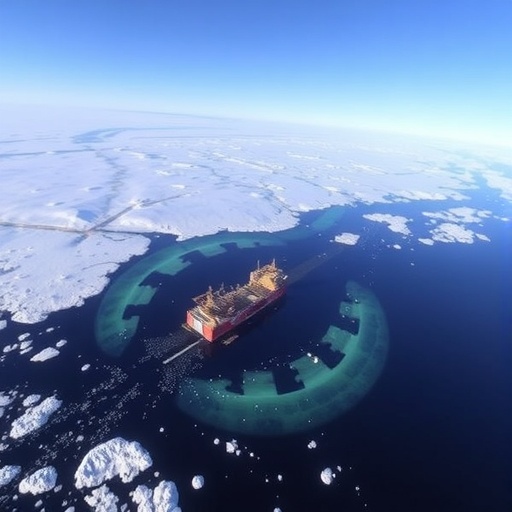The vast and enigmatic expanse of the Northeast Greenland continental shelf has been a focus of scientific curiosity, revealing natural phenomena that have far-reaching implications for our understanding of hydrocarbon seepage and its role in oceanic ecosystems. Recent research conducted by Böttner, Jakobsen, Nielsen, and their colleagues sheds light on the complex dynamics of natural hydrocarbon release in this unique geographical region. The authors meticulously document the occurrence, character, and impact of hydrocarbon seepage, contributing significantly to the field of environmental studies and marine geology.
Hydrocarbon seepage is a natural process wherein hydrocarbons, including oil and gas, migrate from subterranean reservoirs into the ocean or atmosphere. This phenomenon can be driven by tectonic activities and the geological intricacies of the seabed. In Northeast Greenland, the team observed extensive seepage patterns, suggesting that geological formations in the area are not only conducive to hydrocarbon accumulation but also capable of releasing these substances into marine environments. Understanding these processes is essential for predicting ecological impacts and assessing potential energy resources.
The study illuminates the methodologies employed by the researchers to investigate these natural seeps. Using advanced geophysical techniques, the team mapped the locations of visible seepage and analyzed sediment cores to identify hydrocarbons within the geological layers. These techniques provided a comprehensive view of both contemporary and historical seepage events, allowing the researchers to chart the evolution of hydrocarbon emissions over time. The combination of surface mapping and subsurface analysis yielded a wealth of data, confirming the presence of significant hydrocarbon reserves that had previously gone undetected.
In the course of their investigations, Böttner et al. also explored the ecological implications of hydrocarbon seepage. The presence of hydrocarbons in the marine environment can profoundly affect local ecosystems, influencing species distribution and population dynamics. While some organisms utilize hydrocarbons as an energy source, others can be adversely affected by high concentrations of these compounds. Understanding the dual nature of hydrocarbon seepage as both a potential resource and an ecological disruptor is crucial for balancing conservation efforts and resource extraction initiatives.
Another fascinating facet of this study involves the implications of climate change on hydrocarbon seepage. As global temperatures rise and polar ice melts, the geological stability of hydrocarbon reservoirs could be threatened. The researchers raised concerns about the potential for increased seepage under changing climate conditions, which could inadvertently contribute to rising greenhouse gas emissions. This aspect of their research emphasizes the need for a multidisciplinary approach, integrating geology, ecology, and climate science to address the interconnected challenges posed by global change.
The data presented in the study also feeds into broader discussions about energy transition and the role of natural hydrocarbon sources. While society grapples with reducing reliance on fossil fuels, the insights gained from understanding natural seepage processes can inform responsible resource management strategies. The researchers advocate for a careful examination of natural seeps to better assess their potential contributions to sustainable energy practices and carbon management initiatives.
In addition to its scientific contributions, the research highlights the importance of interdisciplinary collaboration. Böttner and his team comprised geologists, ecologists, and climate scientists, each bringing unique perspectives to the study. This collaborative spirit is vital for addressing multifaceted environmental issues that often transcend traditional disciplinary boundaries. Their work serves as a model for future research efforts aimed at understanding the complexities of natural systems and human impacts.
The findings of this research have implications beyond the academic community, resonating with policymakers and stakeholders concerned about climate resilience and marine conservation. As discussions around methane emissions and their impact on climate intensify, the insights from Northeast Greenland can inform policy decisions, particularly in regions susceptible to hydrocarbon seepage. Strategies that take into account the natural behavior of these the hydrocarbons can lead to more sustainable approaches to energy extraction and environmental protection.
Critically, the research underscores the importance of ongoing monitoring and assessment of hydrocarbon seepage. Continued research in the Northeast Greenland continental shelf can yield invaluable data essential for understanding seasonal patterns and long-term trends in hydrocarbon emissions. By establishing a framework for ongoing observation, scientists can better predict the ecological consequences of seepage and refine mitigation strategies to safeguard marine ecosystems.
Böttner et al.’s work represents a significant step forward in our understanding of natural hydrocarbon seepage, providing a wealth of knowledge that could inspire future investigations. Their findings illuminate the intricate connections between geology, ecology, and climate, and they emphasize the importance of embracing interdisciplinary approaches. As the world navigates the challenges of climate change and sustainable resource management, research like this has the potential to shape informed decision-making and foster a deeper appreciation for our planet’s complex systems.
In the end, the study of natural hydrocarbon seepage at the Northeast Greenland continental shelf is not just about hydrocarbons but also about the intricate web of life that exists within marine environments. The revelations brought forth by Böttner and colleagues remind us of the delicate balance between natural processes and human impact, urging us to approach resource management with both caution and curiosity. As research advances, so too does our understanding of how to coexist with the planet’s natural systems responsibly.
In summary, the groundbreaking work undertaken by Böttner and his collaborators opens up new avenues for understanding the dynamics of hydrocarbon seepage and its multifaceted implications. As we continue to grapple with the challenges of climate change and dwindling natural resources, such studies highlight the need for comprehensive strategies that consider both the capabilities and vulnerabilities of our Earth’s systems.
Subject of Research: Hydrocarbon seepage on the Northeast Greenland continental shelf
Article Title: Natural hydrocarbon seepage at the Northeast Greenland continental shelf
Article References:
Böttner, C., Jakobsen, F.W., Nielsen, T. et al. Natural hydrocarbon seepage at the Northeast Greenland continental shelf. Commun Earth Environ 6, 879 (2025). https://doi.org/10.1038/s43247-025-02932-8
Image Credits: AI Generated
DOI: https://doi.org/10.1038/s43247-025-02932-8
Keywords: Hydrocarbon seepage, Northeast Greenland, marine ecology, climate change, interdisciplinary research




